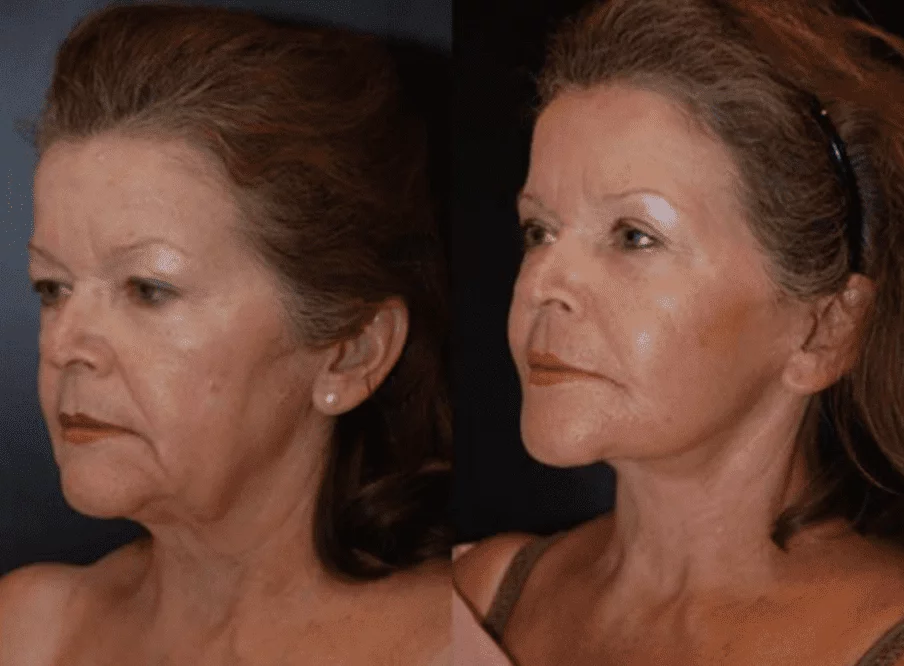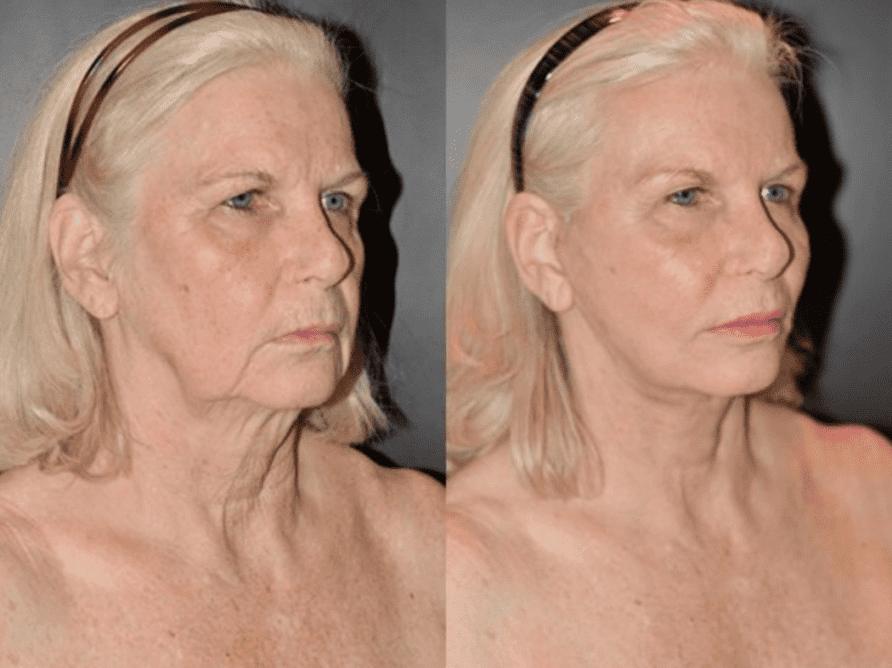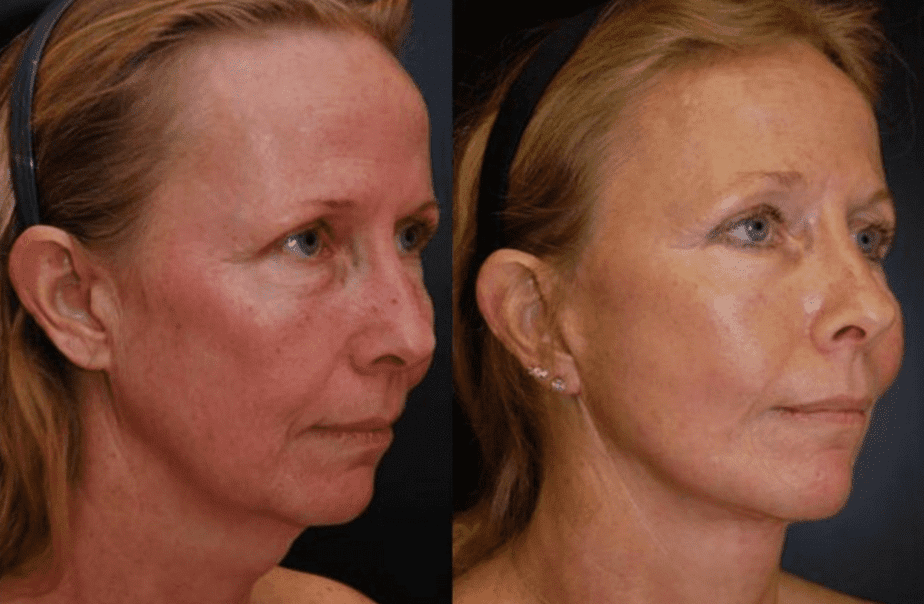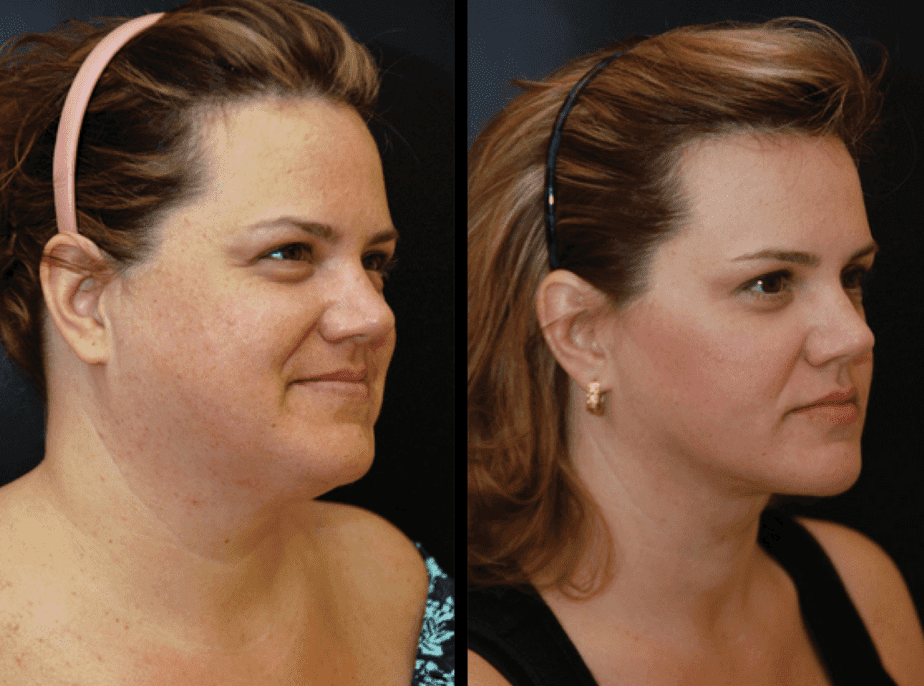Why Get a Facelift?
Over the past century, American life expectancies have risen by about 30 years. It’s hard for our facial skin and support tissues to keep up. Even if you work hard to protect your skin from sun damage and the effects of various personal habits, such as smoking, you still can’t control your body’s collagen production. Collagen is a protein spiral that provides structural support to nearly every tissue of the body including the skin’s epidermis, dermis fat and muscle strength.
Every year after your 20th birthday, your body produces an additional one-percentage point less collagen. Producing 30 percent less collagen at the age of 50 shows itself in deep creases beside the mouth, hanging jowls, sunken cheeks, loose skin folds, fat deposits on the neck, and an overall loose, saggy look.
A facelift with Dr. Dean Kane in Baltimore can reverse this appearance!
Facelift Before & After Photos

**Individual results may vary from patient to patient**
Video: Watch Milly’s Testimonial After Her Facelift Surgery With Dr. Kane
What Is A Facelift?
The idea of tightening aging facial skin isn’t new — the first documented facelift was performed in Berlin in 1901. Clinically known as rhytidectomy, this facelift was a surgical procedure that addresses the visible signs of aging in the mid and lower face and the upper neck by removing the skin excess along a crease in front of the ear. Dr. Kane uses different methods to smooth and tighten the skin of the cheeks, the chin, and the upper neck.
Greater duration and lifting ability occurred when a second layer lift was developed in the early 1960’s tensioning the muscle-fascia tissues under the fat called the SMAS. During Dr. Kane’s procedure, the skin is lifted and underlying muscle and tissue is repositioned to its former higher position. Excess skin is then trimmed and the skin is tucked into minimally visible creases in front of and behind the ear.*
Watch Video: Lauri Kane Explains The Facelift Procedure
Who Is A Good Candidate For A Facelift?
Just about everyone over the age of 45 would be a candidate for some sort of facial skin tightening. The method used by Dr. Kane varies depending on the patient and the degree of sagging. Generally, a facelift rejuvenates the mid-to-lower face and neck. These are some of the typical reasons people come to Dr. Kane for a facelift:
- You have mid-face sagging
- You have deep creases under your eyes
- You have deep nasolabial folds
- Jowls have formed on your jawline
- You have fatty, sagging areas just below your cheekbones
- You have loose skin, wrinkles, vertical cords, and fatty tissue on your neck*
Are There Different Types Of Facelift Procedures?
No two facelifts are completely alike because Dr. Kane tailors each procedure to the patient. Twenty years ago, most patients had what is now called a “traditional or full” facelift. But newer techniques and methods provide different options for incision lengths and locations.
Traditional Facelift
— A traditional facelift involves the largest degree of lifting and repositioning of underlying muscle and other tissue. Certain attachments are removed for a natural look. Dr. Kane usually sculpts the fat rather than removing it. This avoids the hollow look that you may have seen in some poorly executed facelifts. The goal is to rejuvenate the lower third of the face, jowls, and neck. Incisions begin at the temples on each side of the face, run down in front of the ears, wrap around the earlobes, and end in the hairline behind the ears. If the patient has extensive jowls, a second incision may be made under the chin to provide access to the skin and muscle of the upper neck. Excess skin is trimmed, and then the skin is re-draped and sutured in place with dissolving threads.

Traditional Face and Neck Lift with Platysmaplasty Tightening of Neck Muscles*
Mini facelift
— Mini facelifts are the most common type of facelift performed today. Their focus on the lower third of the face is where people commonly show the most aging. Limited incisions are made around the ears, making recovery and scarring far less involved than a full facelift. Dr. Kane pays special attention to the underlying muscular system in this procedure. This provides significant results that still look natural. Mini facelifts primarily target the jaw, lower cheeks, and neck.

Mini Face Lift with No Platysmaplasty Tightening of Neck Muscles*
Learn More About Mini Facelifts
Silhouette InstaLift
— The Silhouette InstaLift isn’t a true “surgical” facelift, and it doesn’t create any incisions. Instead this minimally invasive facelift uses dissolvable threads that have a series of tiny cones spaced down the thread. Dr. Kane inserts the thread through a tiny puncture and places it under the skin where the cones anchor the suture into place, lifting and suspending the skin and tightening the area. The results provide a subtle facelift of the cheeks, jowls, and upper neck, but without the surgery and immediate downtime. Beyond the thread’s instant lifting characteristics, as the threads made from prolonged dissolving molecules (used for decades in most surgical repairs) begin to be absorbed where they also trigger a wound response, with the fibroblasts in the body producing new collagen in the area, further tightening and supporting or firming the skin and surrounding tissues.*

Silhouette InstaLift and Thermi-Tight Combination*
**Individual results may vary from patient to patient**
Learn More About the Silhouette Instalift
What Is Recovery Like After A Facelift?
Your recovery depends on the method Dr. Kane employed for your facelift. Silhouette InstaLifts don’t have any true incisional “recovery,” as there are no cuts made on the visible skin. Patients have bruising and swelling after the insertion of the threads, but this usually clears in 3-14 days. The threads need time to intertwine most effectively stimulate the wound or collagen building response with your tissue, you’ll need to avoid strenuous exercise and exaggerated movements of the thread sites for about three weeks.
Surgical facelifts lift and reposition a larger amount of tissue and usually involve anchoring underlying muscle, so patients have more tissue trauma, swelling, and bruising. As you would expect, these issues will be more extreme with a full facelift versus a mini facelift. With a full lift, Dr. Kane will wrap your face in bandages, and he’ll likely place some drainage tubes to keep fluid accumulation in check. Your first week or so you’ll need to sleep with your head elevated, making sure not to roll over onto your face.
The first few days will be the most difficult, but then you’ll feel better quickly. As you recover, there will be some numbness in areas. This is normal and is a result of the facial nerves re-growing into the re-draped skin. It’s likely that your face will feel stiff, tight, even a little distorted, but this relaxes within 3 to 6 months. Most patients can return to work by the third week after surgery.
With mini facelifts, swelling and bruising usually peak two days or so after your surgery. You’ll still need to sleep with your head elevated for a few days. Compared to a full facelift, patients can usually return to work in as little as a week, but more time off is recommended to allow the proper healing time.*
What Other Procedures Can Be Combined With A Facelift?
People sometimes make the mistake of thinking that, because of the name, a facelift rejuvenates the entire face. That’s not the case. The upper third of the face is not addressed with a facelift. To extend your rejuvenation, patients often opt to have both a facelift and a brow lift. Or they combine their facelift with eyelid surgery to address aging around the eyes. If you have more extreme sagging on the neck, including a neck lift could be beneficial.*

Brow Lift and Lower Eyelid Lift / Blepharoplasty*

Neck Lift with Platysmaplasty Tightening of Neck Muscles and No Skin Removal*
How Long Will My Results Last?
As you may anticipate, Silhouette InstaLift results endure the shortest period: lasting one to two years as they. Surgical facelifts provide the longest results; an average of 7 years depending on the amount of collagen in the skin. They will take time to fully show themselves, often requiring from 9-12 months for all swelling to completely resolve. Your face will continue to age, but it will begin from a younger starting point, if that makes sense. Most people say that full facelifts take from 10-15 years off. As your face continues to sag naturally with time, many patients opt to return to Dr. Kane and have another, much more limited procedure in five to 10 years to keep up with the process of aging and use other collagen stimulating procedures to retain the investment longer.
Recovery times vary with different methods. You can begin walking almost immediately, but it needs to start out on a low-key basis. Generally, vigorous exercise, any lifting (where there is strain across your face), and sexual activity needs to wait for at least 3 weeks. It’s important to keep your blood pressure and swelling from rising on your face. You will need to avoid hot air blow dryers, saunas and steam rooms for a couple months. Dr. Kane will discuss with you what you can expect.*
Facelift Patient Testimonial
Watch Video: Lauri Kane hits her 3 year Facelift anniversary and describes what she does to maintain youthful appearance.
*Actual patients of Dr. Dean Kane. Results may vary from patient to patient. No results are guaranteed.
To find out about facial procedures in Maryland, call the Center for Cosmetic Surgery & MediSpa at (410) 602-3322 and ask for Lauri Kane. Schedule a Consultation Today


